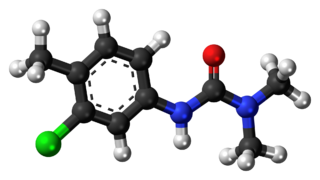
Paraquat (trivial name; ), or N,N′-dimethyl-4,4′-bipyridinium dichloride (systematic name), also known as methyl viologen, is a toxic organic compound with the chemical formula [(C6H7N)2]Cl2. It is classified as a viologen, a family of redox-active heterocycles of similar structure. This salt is one of the most widely used herbicides worldwide. It is quick-acting and non-selective, killing green plant tissue on contact.

An agrochemical or agrichemical, a contraction of agricultural chemical, is a chemical product used in industrial agriculture. Agrichemical typically refers to biocides alongside synthetic fertilizers. It may also include hormones and other chemical growth agents. Though the application of mineral fertilizers and pesticidal chemicals has a long history, the majority of agricultural chemicals were developed from the 19th century, and their use were expanded significantly during the Green Revolution and the late 20th century. Agriculture that uses these chemicals is frequently called conventional agriculture.

Herbicidal warfare is the use of substances primarily designed to destroy the plant-based ecosystem of an area. Although herbicidal warfare use chemical substances, its main purpose is to disrupt agricultural food production and/or to destroy plants which provide cover or concealment to the enemy, not to asphyxiate or poison humans and/or destroy human-made structures. Herbicidal warfare has been forbidden by the Environmental Modification Convention since 1978, which bans "any technique for changing the composition or structure of the Earth's biota".

Diquat is the ISO common name for an organic dication that, as a salt with counterions such as bromide or chloride is used as a contact herbicide that produces desiccation and defoliation. Diquat is no longer approved for use in the European Union, although its registration in many other countries including the USA is still valid.
Pesticide residue refers to the pesticides that may remain on or in food, after they are applied to food crops. The maximum allowable levels of these residues in foods are stipulated by regulatory bodies in many countries. Regulations such as pre-harvest intervals also prevent harvest of crop or livestock products if recently treated in order to allow residue concentrations to decrease over time to safe levels before harvest.

Chlortoluron, chlorotoluron and CTU are the common names for an organic compound of the phenylurea class of herbicides used to control broadleaf and annual grass weeds in cereal crops.

Phenoxy herbicides are two families of chemicals that have been developed as commercially important herbicides, widely used in agriculture. They share the part structure of phenoxyacetic acid.

Saflufenacil is the ISO common name for an organic compound of the pyrimidinedione chemical class used as an herbicide. It acts by inhibiting the enzyme protoporphyrinogen oxidase to control broadleaf weeds in crops including soybeans and corn.

Benthiocarb is a thiocarbamate cholinesterase inhibitor used as an herbicide. Benthiocarb is almost always used to control the weeds around rice crops, but its effectiveness is not specific to just rice crops. The benthiocarb molecule is an organic molecule containing a phenol bonded to a chlorine atom.

Lactofen is a complex ester of acifluorfen and is a nitrophenyl ether selective herbicide and fungicide. It is used in postemergence applications to certain crops which are resistant to its action. The name "Lactofen" is approved by the American National Standards Institute and the Weed Science Society of America, and is also approved in China (乳氟禾草灵).

Acifluorfen is the ISO common name for an organic compound used as an herbicide. It acts by inhibiting the enzyme protoporphyrinogen oxidase which is necessary for chlorophyll synthesis. Soybeans naturally have a high tolerance to acifluorfen and its salts, via metabolic disposal by glutathione S-transferase. It is effective against broadleaf weeds and grasses and is used agriculturally on fields growing soybeans, peanuts, peas, and rice.

Bifenox is the ISO common name for an organic compound used as an herbicide. It acts by inhibiting the enzyme protoporphyrinogen oxidase which is necessary for chlorophyll synthesis.
Mancozeb is a dithiocarbamate non-systemic agricultural fungicide with multi-site, protective action on contact. It is a combination of two other dithiocarbamates: maneb and zineb. The mixture controls many fungal diseases in a wide range of field crops, fruits, nuts, vegetables, and ornamentals. It is marketed as Penncozeb, Trimanoc, Vondozeb, Dithane, Manzeb, Nemispot, and Manzane. In Canada, a mixture of zoxamide and mancozeb was registered for control of the mildew named Gavel as early as 2008.

Fomesafen is the ISO common name for an organic compound used as an herbicide. It acts by inhibiting the enzyme protoporphyrinogen oxidase (PPO) which is necessary for chlorophyll synthesis. Soybeans naturally have a high tolerance to fomesafen, via metabolic disposal by glutathione S-transferase. As a result, soy is the most common crop treated with fomesafen, followed by other beans and a few other crop types. It is not safe for maize/corn or other Poaceae.

Fluazifop is the common name used by the ISO for an organic compound that is used as a selective herbicide. The active ingredient is the 2R enantiomer at its chiral centre and this material is known as fluazifop-P when used in that form. More commonly, it is sold as its butyl ester, fluazifop-P butyl with the brand name Fusilade.

Quizalofop is a chlorophenxy and phenoxy herbicide that works by inhibition of acetyl-CoA-carboxylase to selectively control grasses, without affecting broadleaf crops. It may be shortened to QPE, from Quizalofop-P-Ethyl. It is a Group 1 / A / A herbicide, used in Australia, Morocco and Europe.

Butafenacil is the ISO common name for an organic compound of the pyrimidinedione chemical class used as an herbicide. It acts by inhibiting the enzyme protoporphyrinogen oxidase to control broadleaf and some grass weeds in crops including cereals and canola.

Zuomihuanglong is an herbicide approved for use in China. It is a sulfonylurea compound, and its formula is C17H17N7O5S.

4-(4-Chlorophenoxy)butanoic acid is an herbicide. Its formula is C10H11ClO3. It is an approved substance under the name 4-CPB by the Weed Science Society of America.

















